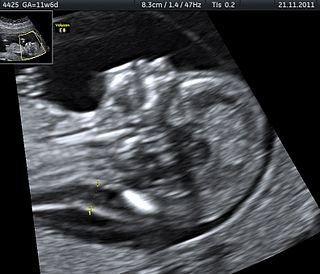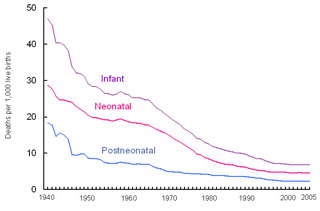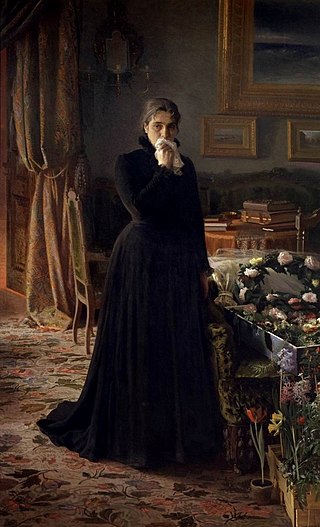Related Research Articles

In vitro fertilisation (IVF) is a process of fertilisation in which an egg is combined with sperm in vitro. The process involves monitoring and stimulating a woman's ovulatory process, then removing an ovum or ova from her ovaries and enabling a man's sperm to fertilise them in a culture medium in a laboratory. After a fertilised egg (zygote) undergoes embryo culture for 2–6 days, it is transferred by catheter into the uterus, with the intention of establishing a successful pregnancy.

Childbirth, also known as labour, parturition and delivery, is the completion of pregnancy where one or more babies exits the internal environment of the mother via vaginal delivery or caesarean section. In 2019, there were about 140.11 million human births globally. In developed countries, most deliveries occur in hospitals, while in developing countries most are home births.

Miscarriage, also known in medical terms as a spontaneous abortion, is an end to pregnancy resulting in the loss and expulsion of an embryo or fetus from the womb before it can survive independently. Miscarriage before 6 weeks of gestation is defined as biochemical loss by ESHRE. Once ultrasound or histological evidence shows that a pregnancy has existed, the term used is clinical miscarriage, which can be "early" or "late". Spontaneous fetal termination after 20 weeks of gestation is known as a stillbirth. The term miscarriage is sometimes used to refer to all forms of pregnancy loss and pregnancy with abortive outcomes before 20 weeks of gestation.

In human reproduction, a live birth occurs when a fetus exits the mother showing any definite sign of life such as voluntary movement, heartbeat, or pulsation of the umbilical cord, for however brief a time and regardless of whether the umbilical cord or placenta are intact. After the fetus is expelled from the maternal body it is called a neonate. Whether the birth is vaginal or by caesarean section, and whether the neonate is ultimately viable, is irrelevant.

Stillbirth is typically defined as fetal death at or after 20 or 28 weeks of pregnancy, depending on the source. It results in a baby born without signs of life. A stillbirth can often result in the feeling of guilt or grief in the mother. The term is in contrast to miscarriage, which is an early pregnancy loss, and sudden infant death syndrome, where the baby dies a short time after being born alive.

Pregnancy is the time during which one or more offspring develops (gestates) inside a woman's uterus (womb). A multiple pregnancy involves more than one offspring, such as with twins.
Prenatal development involves the development of the embryo and of the fetus during a viviparous animal's gestation. Prenatal development starts with fertilization, in the germinal stage of embryonic development, and continues in fetal development until birth.

Complications of pregnancy are health problems that are related to, or arise during pregnancy. Complications that occur primarily during childbirth are termed obstetric labor complications, and problems that occur primarily after childbirth are termed puerperal disorders. While some complications improve or are fully resolved after pregnancy, some may lead to lasting effects, morbidity, or in the most severe cases, maternal or fetal mortality.

Perinatal mortality (PNM) is the death of a fetus or neonate and is the basis to calculate the perinatal mortality rate. Perinatal means "relating to the period starting a few weeks before birth and including the birth and a few weeks after birth."
A memory box is a box containing objects that serve as reminders.
Pregnancy and Infant Loss Remembrance Day is an annual day of remembrance observed on October 15 for pregnancy loss and infant death, which includes miscarriage, stillbirth, SIDS, ectopic pregnancy, termination for medical reasons, and the death of a newborn. Pregnancy and infant loss is a common experience that has historically been complicated by broadly applied social and cultural taboos to stay silent, a condition that the World Health Organization advocates reversing in favor of open expression. A growing number of public figures have come out in support of open expression, with many leading by example through the disclosure of their personal experiences of pregnancy loss and infant death.

Christine Diane Teigen is an American model, television personality, and author. She made her professional modeling debut in the annual Sports Illustrated Swimsuit Issue in 2010 and appeared on the 50th-anniversary cover alongside Nina Agdal and Lily Aldridge in 2014.

Mizuko kuyō (水子供養) meaning "water child memorial service", is a Japanese Buddhist ceremony for those who have had a miscarriage, stillbirth, or abortion. It is also practiced in Thailand and China. This practice has become particularly visible since the 1970s with the creation of shrines devoted solely to this ritual. Reasons for the performance of these rites can include parental grief, desire to comfort the soul of the fetus, guilt for an abortion, or even fear of retribution from a vengeful ghost.
In Judaism, views on abortion draw primarily upon the legal and ethical teachings of the Hebrew Bible, the Talmud, the case-by-case decisions of responsa, and other rabbinic literature. While most major Jewish religious movements discourage abortion, except to save the life of a pregnant woman, authorities differ on when and whether it is permitted in other cases.
Antenatal depression, also known as prenatal or perinatal depression, is a form of clinical depression that can affect a woman during pregnancy, and can be a precursor to postpartum depression if not properly treated. It is estimated that 7% to 20% of pregnant women are affected by this condition. Any form of prenatal stress felt by the mother can have negative effects on various aspects of fetal development, which can cause harm to the mother and child. Even after birth, a child born from a depressed or stressed mother feels the affects. The child is less active and can also experience emotional distress. Antenatal depression can be caused by the stress and worry that pregnancy can bring, but at a more severe level. Other triggers include unplanned pregnancy, difficulty becoming pregnant, history of abuse, and economic or family situations.
The Mariposa Trust is a charity in the United Kingdom founded by Zoë Clark-Coates, to support people who have suffered baby loss, in pregnancy, at birth or in infancy. It holds public Services of Remembrance, of any or no religious faith, across the UK to acknowledge the loss of a baby by their families, and by arranging specialist support divisions to help people with their associated grief and trauma. It is one of the organizations that supports baby loss awareness week.
Jamie Nicole Hehner is an American television personality and jewelry designer who first appeared as a contestant on the sixteenth season of The Bachelor. She is best known for participating in the first season of Married at First Sight, where she met her husband, Doug Hehner. The couple was later featured in a spin-off series, Married at First Sight: The First Year. They have since appeared in several specials on FYI.

Miscarriage and grief are both an event and subsequent process of grieving that develops in response to a miscarriage. Almost all those experiencing a miscarriage experience grief. This event is often considered to be identical to the death of a child and has been described as traumatic. "Devastation" is another descriptor of miscarriage. Grief is a profound, intensely personal sadness stemming from irreplaceable loss, often associated with sorrow, heartache, anguish, and heartbreak. Sadness is an emotion along with grief, on the other hand, is a response to the loss of the bond or affection was formed and is a process rather than one single emotional response. Grief is not equivalent to depression. Grief also has physical, cognitive, behavioral, social, cultural, and philosophical dimensions. Bereavement and mourning refer to the ongoing state of loss, and grief is the reaction to that loss. Emotional responses may be bitterness, anxiety, anger, surprise, fear, and disgust and blaming others; these responses may persist for months. Self-esteem can be diminished as another response to miscarriage. Not only does miscarriage tend to be a traumatic event, women describe their treatment afterwards to be worse than the miscarriage itself.
Perinatal bereavement or perinatal grief refers to the emotions of the family following a perinatal death, defined as the demise of a fetus or newborn infant. Perinatal loss affects one in every ten women across the globe with the worldwide perinatal death rate at approximately 2.7 million deaths per year. Perinatal death is recognized as a traumatic life event as it is often sudden, unexpected, and devastating to parents who have had little to no direct life experiences with their child before their death.
The Memory Garden is the first Jewish sacred space in the United States dedicated to expressing grief over infertility, pregnancy loss due to miscarriage or abortion, or stillbirth or death of a newborn. Judaism has a complex definition of the beginning of life, and does not have a traditional ritual for mourning fetuses or newborns prior to the age of thirty days. The Memory Garden builds on existing traditions, following halakah, and acknowledges the need of expectant parents and other family members across all streams of Jewish practice to recognize the emotional toll these losses take.
References
- ↑ "Stillbirth". medlineplus.gov. Archived from the original on September 9, 2024. Retrieved October 29, 2020.
- ↑ Kasprzak, Emma (February 23, 2017). "Rainbow babies: The children bringing hope after loss". BBC News. Archived from the original on September 9, 2024. Retrieved September 15, 2019.
- ↑ "Pregnancy after miscarriage: What you need to know - Mayo Clinic". www.mayoclinic.org. Archived from the original on September 9, 2024. Retrieved October 29, 2020.
- ↑ Gold, Katherine J; Sen, Ananda; Hayward, Rodney A. (May 2010). "Marriage and Cohabitation Outcomes After Pregnancy Loss". Pediatrics . 125 (5): e1202 –e1207. doi:10.1542/peds.2009-3081. PMC 2883880 . PMID 20368319.
- ↑ "'Rainbow Baby' Photo Captures Grieving Michigan Mom's Emotional Journey Following Miscarriage: 'Knowing I Wasn't Alone Helped'". People . Archived from the original on October 11, 2019. Retrieved September 14, 2019.
- ↑ Willets, Melissa. "What It Means to Be a 'Rainbow Baby' and Why Rainbow Babies Are Beautiful: Parents and experts explain why rainbow babies, born after a stillbirth, or neonatal death, are something beautiful after a scary and dark experience". Parents . Archived from the original on September 9, 2024. Retrieved September 14, 2019.
- ↑ "Thursday is National Rainbow Baby Day". WMTV . Madison, Wisconsin. August 22, 2019. Archived from the original on September 9, 2024. Retrieved September 14, 2019.
- ↑ Johnson, Cierra (August 26, 2019). "Columbus photographer takes photos of rainbow babies free of charge". Columbus, Ohio: WBNS-TV. Archived from the original on September 13, 2019. Retrieved September 14, 2019.
- ↑ Kalsi, Dal (August 22, 2019). "Upstate mothers gather to celebrate Rainbow Baby Day with special photo". WHNS. Archived from the original on September 9, 2024. Retrieved September 14, 2019.
- ↑ Ritschel, Chelsea (August 8, 2019). "Mothers pose with their rainbow babies in emotional photo shoot". The Independent. Archived from the original on August 9, 2019. Retrieved September 15, 2019.
- ↑ Hanson, Kait (October 13, 2021). "Why some parents dislike the term 'rainbow baby'". Today . Archived from the original on September 9, 2024. Retrieved October 17, 2021.